Last weekend I was shooting my Glock 19, Gen 5 and came to the conclusion that the grip on that handgun was not very comfortable. The texture on the grip is very grippy but not what I like on my handgun grips. Even though a 9mm does not kick very bad, I still like a rubber grip on my handguns so the stock grips are not exactly what I want for my EDC handgun. So lets talk about the possibilities.
and came to the conclusion that the grip on that handgun was not very comfortable. The texture on the grip is very grippy but not what I like on my handgun grips. Even though a 9mm does not kick very bad, I still like a rubber grip on my handguns so the stock grips are not exactly what I want for my EDC handgun. So lets talk about the possibilities.
What Are My Options?
There are a few things that I can do to change the grip feel. 1) I could send it off to a gun company to re-stipple the the grips. 2) I could buy a Hogue Grip Rubber Sleeve or 3) I could get a set of Talon Adhesive Grips for my handgun. There are more options but those are the ones I have chosen.
- Having a gun company
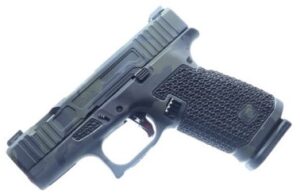 stipple my handgun grip is kind of a costly project, not to mention it usually takes 2 to 5 weeks before you get them back. Is it nice? For sure it is! Does it look cool -Yes! But I do not want to pay an extra $100 to $500 just to texture my grips.
stipple my handgun grip is kind of a costly project, not to mention it usually takes 2 to 5 weeks before you get them back. Is it nice? For sure it is! Does it look cool -Yes! But I do not want to pay an extra $100 to $500 just to texture my grips. - Buying a Hogue Rubber
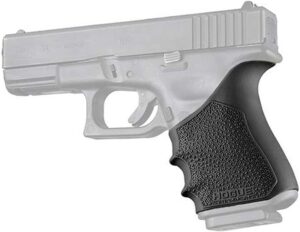 Grip Sleeve for my Glock ia another possibility. The cost is around $16 from Amazon, which is not a bad price.
Grip Sleeve for my Glock ia another possibility. The cost is around $16 from Amazon, which is not a bad price. - Lastly is the Talon Adhesive Grip
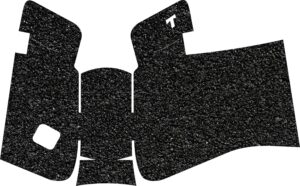 , I have one of these on my Glock 20 and it really works great. They are very easy to install and they seem to last a long time. You can get them in textured rubber or a sand paper finish. The rubber texture is the one is the one that I like and the cost from Amazon is $19.99.
, I have one of these on my Glock 20 and it really works great. They are very easy to install and they seem to last a long time. You can get them in textured rubber or a sand paper finish. The rubber texture is the one is the one that I like and the cost from Amazon is $19.99.
- Having a gun company
What Have I Chosen To Do?
All three of those options would be great choices to give me a better grip feel. But right off the bat I would have to decline the stippling of my grip due to the cost factor. Its not that I am “cheap” but I am “practical” and spending that much extra money on a handgun is more than I can justify. As far as the Hogue Rubber Grip Sleeve goes, I am concerned that the rear beavertail portion of the grip might roll down which would defeat the whole purpose of having this grip. Since I have used the Talon Adhesive Grip before and I really like them I have decided to go with this grip.
How Do You Install It?
- FIELD STRIP HANDGUN – Unload and Field Strip your Handgun for safet
- TEST THE GRIP FIT – Do a Test Fit to ensure you have the correct grip and to understand how the grip fits your firearm.
- CLEAN THE GRIP – Use the rubbing alcohol pad to clean the handgun grip area removing any dirt or oil. Then let the handgun dry completely before proceeding to next step.
- ALIGN/WRAP/TUCK THE GRIP – Remove the backing on the grip. Start with the left side, ALIGN the Talon Grip with the front and bottom of the factory pistol grip, maintaining a consistent reveal around the maxwell. DO NOT STRETCH, gently WRAP the grip on to prevent trapping air. Make sure the grip is properly centered on the backstrap. Very lightly wrap the finger panel evenly around the front of the pistol. TUCK any excess material UNDER the left side panel. If the Talon Grip is misaligned, gently peel back the grip, reposition the panel, and reapply as many times as needed.
- HEAT/PRESS/REPEAT – When the Talon grip is properly aligned HEAT it with a hair dryer or heat gun to the temperature of a warm cup of coffee and PRESS FIRMLY into place. Do not heat over 130 degrees. REPEAT this step several times conforming the Talon Grip to the gun’s factory grip. Pay special attention to pressing down firmly all outside edges, including the backstrap.
How Do They Feel?
I really like the feel of these grips, they are smooth but very grippy and they do not create any hot spots. It is very easy to hang on to the pistol throughout the shooting phase, no readjustments are necessary. No this being a 9mm, that is not really even possible. But with my 10mm handgun, that really kicks a lot, that is where you notice this the most.
Final Comments
In this article I talked about three types of grips for my Glock 19, Gen 5. If I was totally honest I would say that stippling my Glocks grip would be totally awesome. It looks great, it would feel great and would really do the job, but at a rather large price! I love my handguns but the purchase is enough and I have a hard time justifying paying almost what I paid for the gun to get it stippled. When I compare the Hogue Rubber Grip Sleeve and the Talon Adhesive Grips, Talon Grips won out. If you need a new grip on your handgun you might try the Talon Adhesive Grips. they work great and are easy to install. They are available on Amazon.com.
If you have any questions about this post or anything related to Everyday Carry (EDC), feel free to leave a comment below and I will be happy to get back to you.
All the best,
Larry
Founder of EDC Essentials
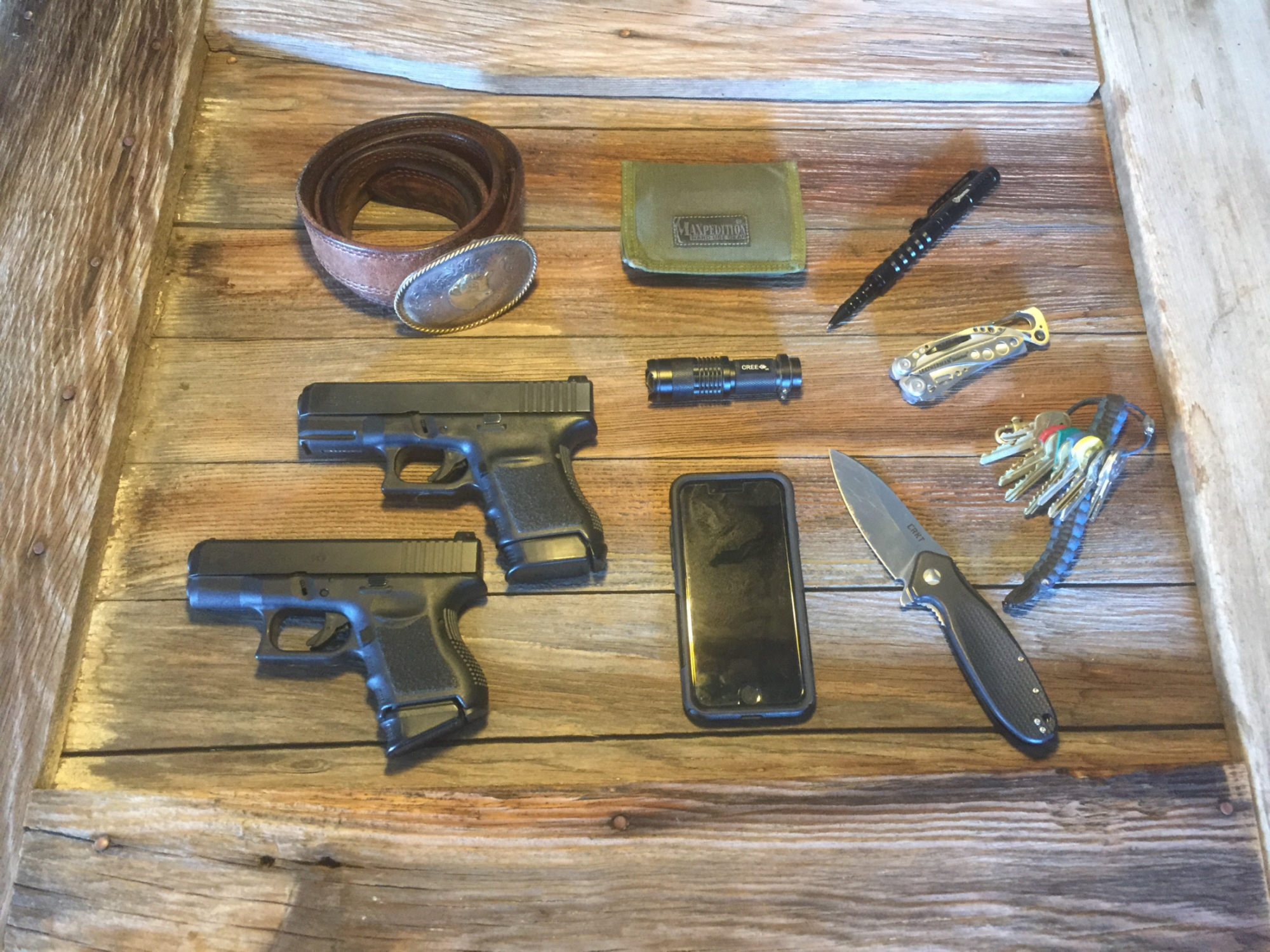

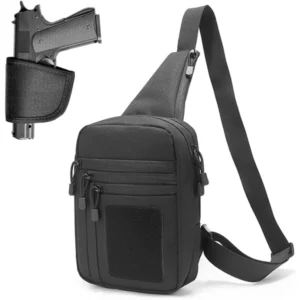 and all I wear is a t-shirt and a pair of Wranglers, I do wear a small sling pack (or bag) to carry my handgun in. Recently I bought a Raptor Sling Pack which seems to work very well. I did a review on this bag on September 30, 2025, if you are interested in that. This bag is smaller than a full backpack and works great as a concealed carry bag. If this pack is something that might appeal to you, then check it out. The holsters that come with both of these backpacks are not very good in my opinion and so let’s explore this topic a little further.
and all I wear is a t-shirt and a pair of Wranglers, I do wear a small sling pack (or bag) to carry my handgun in. Recently I bought a Raptor Sling Pack which seems to work very well. I did a review on this bag on September 30, 2025, if you are interested in that. This bag is smaller than a full backpack and works great as a concealed carry bag. If this pack is something that might appeal to you, then check it out. The holsters that come with both of these backpacks are not very good in my opinion and so let’s explore this topic a little further.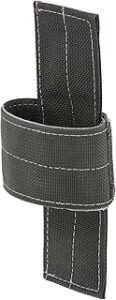 are made by Maxpedition and Dinosaurized: An Army Store and they have a couple of styles of backpack holsters that they offer for their concealed carry backpacks. They are the Velcro straps that can be placed around your handgun to universally fit many sizes of handguns. The back of the universal handgun holster has Velcro on it so it can be placed anywhere the backpack has Velcro attached to the backpack. There are other brands of concealed carry backpacks; Vertx, Blackhawk, 5.11, Glock, Alpine Concealed, Voodoo, Eberlestock, Red Rock, Elite Survival Systems, Wolf Tactical, Viktos, Advance Warrior Solutions, etc. which use the same type of holster for their backpacks. Some of them are included with their backpack and others you need to purchase separately.
are made by Maxpedition and Dinosaurized: An Army Store and they have a couple of styles of backpack holsters that they offer for their concealed carry backpacks. They are the Velcro straps that can be placed around your handgun to universally fit many sizes of handguns. The back of the universal handgun holster has Velcro on it so it can be placed anywhere the backpack has Velcro attached to the backpack. There are other brands of concealed carry backpacks; Vertx, Blackhawk, 5.11, Glock, Alpine Concealed, Voodoo, Eberlestock, Red Rock, Elite Survival Systems, Wolf Tactical, Viktos, Advance Warrior Solutions, etc. which use the same type of holster for their backpacks. Some of them are included with their backpack and others you need to purchase separately. 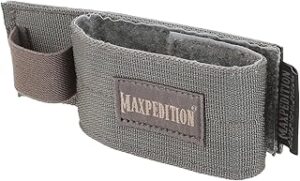 Some people like this style of Velcro backpack holster, they are handy, versatile and economical but it is not what I like to use in my backpack.
Some people like this style of Velcro backpack holster, they are handy, versatile and economical but it is not what I like to use in my backpack. that I never heard of before. Their name was Cook’s Holsters and they really did a fine job with these holsters. I have ordered two of their holsters about 6 – 7 years ago and they really impressed me. These are especially made to fit flat, like in a backpack and that flat section of the holster is large enough
that I never heard of before. Their name was Cook’s Holsters and they really did a fine job with these holsters. I have ordered two of their holsters about 6 – 7 years ago and they really impressed me. These are especially made to fit flat, like in a backpack and that flat section of the holster is large enough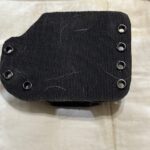 to hold a large piece of Velcro that will really sticks to the side of a backpack. Plus it clicks in place and will not come out without a good tug on the handgun by your hand. They worked really awesome for me and I liked them a lot. Then when I got the Raptor Sling Bag I tried to contact them but then they were gone. Their website is still there but I got not response by phone or email. And I thought I would just need to forget about these holsters and utilize something else.
to hold a large piece of Velcro that will really sticks to the side of a backpack. Plus it clicks in place and will not come out without a good tug on the handgun by your hand. They worked really awesome for me and I liked them a lot. Then when I got the Raptor Sling Bag I tried to contact them but then they were gone. Their website is still there but I got not response by phone or email. And I thought I would just need to forget about these holsters and utilize something else. again, but all I found were the Cordura styles and nothing made out of Kydex. Then I tried to look up flat-backed Kydex holster and I found what I needed. A company named Crossbreed Holsters ( ) had a whole line of flat backed holsters for purses, backpacks and bedside holsters. They call their holster a “Modular” holsters, and they do make them either right or left handed. So if you are interested in this type of holster, you might check them out.
again, but all I found were the Cordura styles and nothing made out of Kydex. Then I tried to look up flat-backed Kydex holster and I found what I needed. A company named Crossbreed Holsters ( ) had a whole line of flat backed holsters for purses, backpacks and bedside holsters. They call their holster a “Modular” holsters, and they do make them either right or left handed. So if you are interested in this type of holster, you might check them out.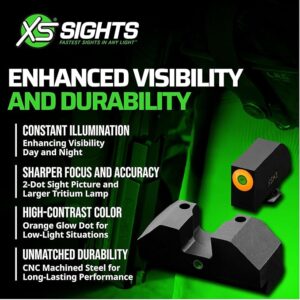 as I feel they have very high quality sights at a somewhat reasonable price. I was looking on Amazon a while back and found a new style of XS Night Sights that I thought might just work for me and besides they were at a very reasonable introductory price. So I thought I would give them a try. I bought three for my Glocks, my Glock 19, 30 and 20. Most of my discussion will be about my Glock 19 (9mm), so let’s talk about it.
as I feel they have very high quality sights at a somewhat reasonable price. I was looking on Amazon a while back and found a new style of XS Night Sights that I thought might just work for me and besides they were at a very reasonable introductory price. So I thought I would give them a try. I bought three for my Glocks, my Glock 19, 30 and 20. Most of my discussion will be about my Glock 19 (9mm), so let’s talk about it.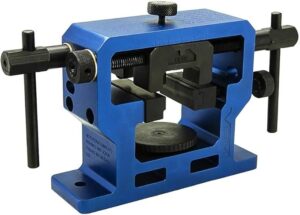 works with many types of semi-auto slides: full, compact, subcompact, and pocket-sized semi-auto pistols. The base platform is adjustable for height, to get your slide and rear sights at the proper height for the rear sight pusher. Includes one bottom spacer for some pocket pistol slides for proper height alignment. The multiple vertical and horizontal clamps secure various sizes and types of semi-auto slides in the tool. The adjustable top brace with a plastic insert to secure the slide’s vertical placement on the base platform. The adjustable side braces with plastic inserts secure the slide’s horizontal placement on the base platform. Includes two sets of side plastic inserts: a pair of flat inserts and a pair of stepped inserts to fit a wide variety of slide profiles.
works with many types of semi-auto slides: full, compact, subcompact, and pocket-sized semi-auto pistols. The base platform is adjustable for height, to get your slide and rear sights at the proper height for the rear sight pusher. Includes one bottom spacer for some pocket pistol slides for proper height alignment. The multiple vertical and horizontal clamps secure various sizes and types of semi-auto slides in the tool. The adjustable top brace with a plastic insert to secure the slide’s vertical placement on the base platform. The adjustable side braces with plastic inserts secure the slide’s horizontal placement on the base platform. Includes two sets of side plastic inserts: a pair of flat inserts and a pair of stepped inserts to fit a wide variety of slide profiles. so that you only have your slide (barrel and spring removed).
so that you only have your slide (barrel and spring removed). the screw is on the inside of the slide.
the screw is on the inside of the slide.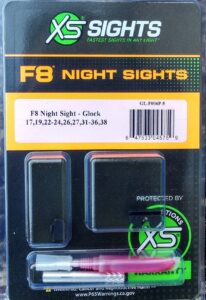 from the packaging and see what you have to work with.
from the packaging and see what you have to work with.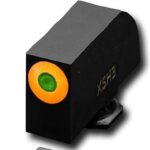 and put a small amount of Loctite on the screw.
and put a small amount of Loctite on the screw. and slide it to the right into the dovetail. It should slide into the dovetail 1/4 to 1/3 of the way into the dovetail, or further fitting will be required.
and slide it to the right into the dovetail. It should slide into the dovetail 1/4 to 1/3 of the way into the dovetail, or further fitting will be required.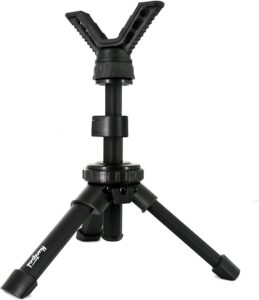 for support (see photo below), a rest like this works for handguns or rifles and helps to remove most of the other movements so you can see exactly where your handgun is shooting.
for support (see photo below), a rest like this works for handguns or rifles and helps to remove most of the other movements so you can see exactly where your handgun is shooting.  market today and it would be a lot easier to just buy one rather than make one. There are a couple different types of brass catchers, one that attaches to your firearm and one that is more universal in nature and stands on your tables and catches the brass as you shoot your weapon. I am looking at a universal brass catcher that can work with many different firearms, handguns and rifles. This first one is made by CTK Precision and costs $65.00. It looks to be adequate but I have not tried it. The second one is made by Caldwell and it costs $49.89 and it too looks like it would
market today and it would be a lot easier to just buy one rather than make one. There are a couple different types of brass catchers, one that attaches to your firearm and one that is more universal in nature and stands on your tables and catches the brass as you shoot your weapon. I am looking at a universal brass catcher that can work with many different firearms, handguns and rifles. This first one is made by CTK Precision and costs $65.00. It looks to be adequate but I have not tried it. The second one is made by Caldwell and it costs $49.89 and it too looks like it would  do the job. So then why not buy one? I guess you could say I am kind of a tight-wad and a bit of an engineer-type and if I can make one just as good (or better) then why not do it. Besides I don’t know about you but I get a lot of personal satisfaction from doing things myself, rather than just buying one.
do the job. So then why not buy one? I guess you could say I am kind of a tight-wad and a bit of an engineer-type and if I can make one just as good (or better) then why not do it. Besides I don’t know about you but I get a lot of personal satisfaction from doing things myself, rather than just buying one. simplicity of operation, and the ability to fire more powerful cartridges than many semi-automatic pistols. A revolver’s straightforward design makes it a dependable choice for self-defense, particularly for new gun owners. Plus they just look very cool!
simplicity of operation, and the ability to fire more powerful cartridges than many semi-automatic pistols. A revolver’s straightforward design makes it a dependable choice for self-defense, particularly for new gun owners. Plus they just look very cool!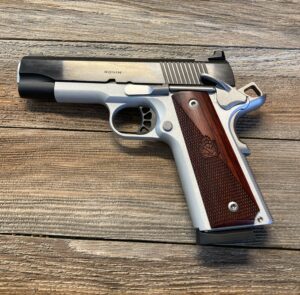 than revolvers. You’ll see some exceptions, but the basic concept that semi-auto’s use – storing ammunition in the magazine – provides more space for cartridges than the cylinder of a revolver.
than revolvers. You’ll see some exceptions, but the basic concept that semi-auto’s use – storing ammunition in the magazine – provides more space for cartridges than the cylinder of a revolver. two of my handguns: a Springfield Armory 1911, .45ACP (top picture) and a Browning Hi Power Mark 3 9mm (bottom picture). I regreted that sale for many years! The 1911 and Hi-Power was both modified at Novak’s Sights with special sights and reliability work that made them shoot great and they were completely reliable. I really hated to sell those two handguns, they were sweet! That taught me that it is not a good idea to sell your firearms because you never get a price that they are really worth to you.
two of my handguns: a Springfield Armory 1911, .45ACP (top picture) and a Browning Hi Power Mark 3 9mm (bottom picture). I regreted that sale for many years! The 1911 and Hi-Power was both modified at Novak’s Sights with special sights and reliability work that made them shoot great and they were completely reliable. I really hated to sell those two handguns, they were sweet! That taught me that it is not a good idea to sell your firearms because you never get a price that they are really worth to you. I was able to replace my Springfield Armory 1911 that I sold with a new Springfield Armory Ronin 1911 which made me very happy. They were both .45 ACP, which is a caliber that I really like. It had a little shorter barrel so it will work better as a concealed carry handgun. It had a lot of the same upgrades from the factory that I had done at Novak’s, so it was a good deal for me.
I was able to replace my Springfield Armory 1911 that I sold with a new Springfield Armory Ronin 1911 which made me very happy. They were both .45 ACP, which is a caliber that I really like. It had a little shorter barrel so it will work better as a concealed carry handgun. It had a lot of the same upgrades from the factory that I had done at Novak’s, so it was a good deal for me. is a modern, American-made 9mm handgun that is a modernized take on the classic John Moses Browning P-35 (Browning Hi-Power) pistol design.
is a modern, American-made 9mm handgun that is a modernized take on the classic John Moses Browning P-35 (Browning Hi-Power) pistol design.  they are a good shooting handgun. I love the fact that these handguns are made in the USA and that this company took the time to make such a close copy and then make the improvements to this gun that the original Browning Hi-Power was lacking. All in all it is a great 9mm handgun, it feels really good in my hand and shoots very good also. The one thing I did not mention was that this handgun is an all steel handgun and therefore will be a fair bit heavier then many of the polymer handguns on the market today. So that means it will be heavier to carry but the extra weight will help to make it more accurate because you will not feel the recoil as much so it will help to stay on target on follow-up shots. This is a great handgun and I am glad to have it back in my gun safe.
they are a good shooting handgun. I love the fact that these handguns are made in the USA and that this company took the time to make such a close copy and then make the improvements to this gun that the original Browning Hi-Power was lacking. All in all it is a great 9mm handgun, it feels really good in my hand and shoots very good also. The one thing I did not mention was that this handgun is an all steel handgun and therefore will be a fair bit heavier then many of the polymer handguns on the market today. So that means it will be heavier to carry but the extra weight will help to make it more accurate because you will not feel the recoil as much so it will help to stay on target on follow-up shots. This is a great handgun and I am glad to have it back in my gun safe. Some people think they are ugly! Some people think they feel like a 2 x 4 in your hand! And some people really like them! I am in the last group.
Some people think they are ugly! Some people think they feel like a 2 x 4 in your hand! And some people really like them! I am in the last group. (right top picture – white and red arrow) was really hard to keep ahold of, while you hold the slide back to a certain place. So you would usually try a couple of times before you could do it. Then came the extended slide stop and that made all the difference in field stripping your Glock. It only stuck out a tiny bit more than the original and the edges were serrated a bit more and that made holding that lever down so much easier.
(right top picture – white and red arrow) was really hard to keep ahold of, while you hold the slide back to a certain place. So you would usually try a couple of times before you could do it. Then came the extended slide stop and that made all the difference in field stripping your Glock. It only stuck out a tiny bit more than the original and the edges were serrated a bit more and that made holding that lever down so much easier.  I go to the Glock Store (https://www.glockstore.com) in California, they have about everything you could think of for your Glocks in the way of parts and accessories. Plus their service is excellent. I ordered this part and about a week later it came in the mail to my residence. This is the part as I got it from the Glock Store, so lets move on with the procedure.
I go to the Glock Store (https://www.glockstore.com) in California, they have about everything you could think of for your Glocks in the way of parts and accessories. Plus their service is excellent. I ordered this part and about a week later it came in the mail to my residence. This is the part as I got it from the Glock Store, so lets move on with the procedure.
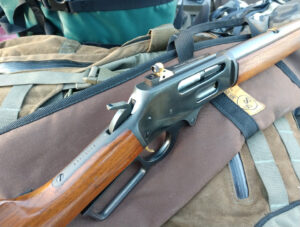 different sight options available on the market today, and everybody seems to want some type of optic as there go-to sight package. My view is that optics are great when they work, but if there is a problem, you are in trouble. So I have switched most of my self defense rifles back to open sights.
different sight options available on the market today, and everybody seems to want some type of optic as there go-to sight package. My view is that optics are great when they work, but if there is a problem, you are in trouble. So I have switched most of my self defense rifles back to open sights. 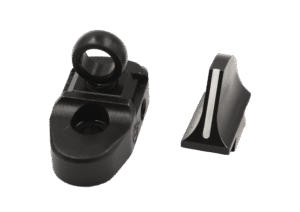 They may not work for long range shooting but most of your self defense shooting is close-up. Let’s explore the peep sight and see if it might be something that would work for you.
They may not work for long range shooting but most of your self defense shooting is close-up. Let’s explore the peep sight and see if it might be something that would work for you. is a popular choice due to its versatility and stopping power, any rifle that is comfortable, controllable, and chambered in an appropriate caliber for the user’s needs can be considered a self-defense rifle.
is a popular choice due to its versatility and stopping power, any rifle that is comfortable, controllable, and chambered in an appropriate caliber for the user’s needs can be considered a self-defense rifle. favorite home defense rifles is the Lever action carbine. the action is quick and easy to cycle and it comes in many different calibers: .357 Mag, .44 Mag and .30-30. Many people like using the .357 Mag or the .44 Mag as a self defense rifle as the recoil is low but the power behind the bullet is adequate for protection.
favorite home defense rifles is the Lever action carbine. the action is quick and easy to cycle and it comes in many different calibers: .357 Mag, .44 Mag and .30-30. Many people like using the .357 Mag or the .44 Mag as a self defense rifle as the recoil is low but the power behind the bullet is adequate for protection. in the rear sight to improve accuracy and vision by helping the shooter center their eye and focus on the front sight.
in the rear sight to improve accuracy and vision by helping the shooter center their eye and focus on the front sight.  manufacturers out there that produce peep sights. I really like Skinner Sights style of peep sights on my Henry lever guns, I have a .30-30, and .45-70 caliber rifles that I use with these sights. (upper picture) they are nicely made and work excellent on these rifles, I also use Williams Sight Company’s 5D peep sight on my Winchester 94 (.30-30)
manufacturers out there that produce peep sights. I really like Skinner Sights style of peep sights on my Henry lever guns, I have a .30-30, and .45-70 caliber rifles that I use with these sights. (upper picture) they are nicely made and work excellent on these rifles, I also use Williams Sight Company’s 5D peep sight on my Winchester 94 (.30-30) , I would rather use the Skinner version but I have run into some issues in getting them ready for those sights. Lastly I use the XS Sight System on my Mossberg shotgun, I have their XS night sights
, I would rather use the Skinner version but I have run into some issues in getting them ready for those sights. Lastly I use the XS Sight System on my Mossberg shotgun, I have their XS night sights on my pump shotguns (12 gauge)(Lower picture). This way the lever guns work great in the daytime and the shotguns work great at night.
on my pump shotguns (12 gauge)(Lower picture). This way the lever guns work great in the daytime and the shotguns work great at night. think of the large traditional Gun safes that are multi compartmentalized and hold 20 plus long guns and many handguns as well. These safes utilize a keypad and/or combination in order to lock and open their doors. Inside they have a carpeted interior with adjustable shelving that will fit anyone’s needs. The one negative thing about these safes is that they are very heavy. Some of the common brand names are AMSEC (American Security, Browning, Liberty Safes, Fort Knox, Hollan, Gunvault, Gardall, Mesa, Ironman, and Mountain House.
think of the large traditional Gun safes that are multi compartmentalized and hold 20 plus long guns and many handguns as well. These safes utilize a keypad and/or combination in order to lock and open their doors. Inside they have a carpeted interior with adjustable shelving that will fit anyone’s needs. The one negative thing about these safes is that they are very heavy. Some of the common brand names are AMSEC (American Security, Browning, Liberty Safes, Fort Knox, Hollan, Gunvault, Gardall, Mesa, Ironman, and Mountain House.
 to have a modular, multiple gun cabinets setup. It can
to have a modular, multiple gun cabinets setup. It can  work however you need it too. Now they usually have a biometric lock mechanism for quicker gun access. There are quite a few companies that offer this type of gun safe: Hornady, Snapsafe, Steelhead Outdoors, but my favorite is Secure-it. They have many to choose from and if they do not have what you want then it may not be available. It breaks the traditional idea about gun safes but it is definitely worth thinking about.
work however you need it too. Now they usually have a biometric lock mechanism for quicker gun access. There are quite a few companies that offer this type of gun safe: Hornady, Snapsafe, Steelhead Outdoors, but my favorite is Secure-it. They have many to choose from and if they do not have what you want then it may not be available. It breaks the traditional idea about gun safes but it is definitely worth thinking about. handgun safes for your home, when trying to decide what you need, these are things to consider:
handgun safes for your home, when trying to decide what you need, these are things to consider: theft resistance, and fire protection.
theft resistance, and fire protection. space you have available and the location you choose for the safe.
space you have available and the location you choose for the safe. all setup then you need to consider your vehicles. The days of throwing your handgun in your glovebox or under the seat is not the best thing to do these days. Even tossing it in your trunk is not the safest thing to do. You don’t want your handgun rattling around in the trunk.
all setup then you need to consider your vehicles. The days of throwing your handgun in your glovebox or under the seat is not the best thing to do these days. Even tossing it in your trunk is not the safest thing to do. You don’t want your handgun rattling around in the trunk. V-line, Hornady, and Stealth Safes. Many of these are sold at Amazon so that is something to consider if you are in the market for a vehicle gun safe. I purchased one from Amazon, MADOATS Car Gun Safe, and it was pretty darn cool and works really well for my pickup. I don’t use it a lot but it is always there incase I need to lock my handgun in my truck. You never know when you are going to the post office, other federal building or need to go inside a school and those are some places that do not allow firearms. If you carry your handgun you should definitely have a secure way to lock up your handgun.
V-line, Hornady, and Stealth Safes. Many of these are sold at Amazon so that is something to consider if you are in the market for a vehicle gun safe. I purchased one from Amazon, MADOATS Car Gun Safe, and it was pretty darn cool and works really well for my pickup. I don’t use it a lot but it is always there incase I need to lock my handgun in my truck. You never know when you are going to the post office, other federal building or need to go inside a school and those are some places that do not allow firearms. If you carry your handgun you should definitely have a secure way to lock up your handgun.